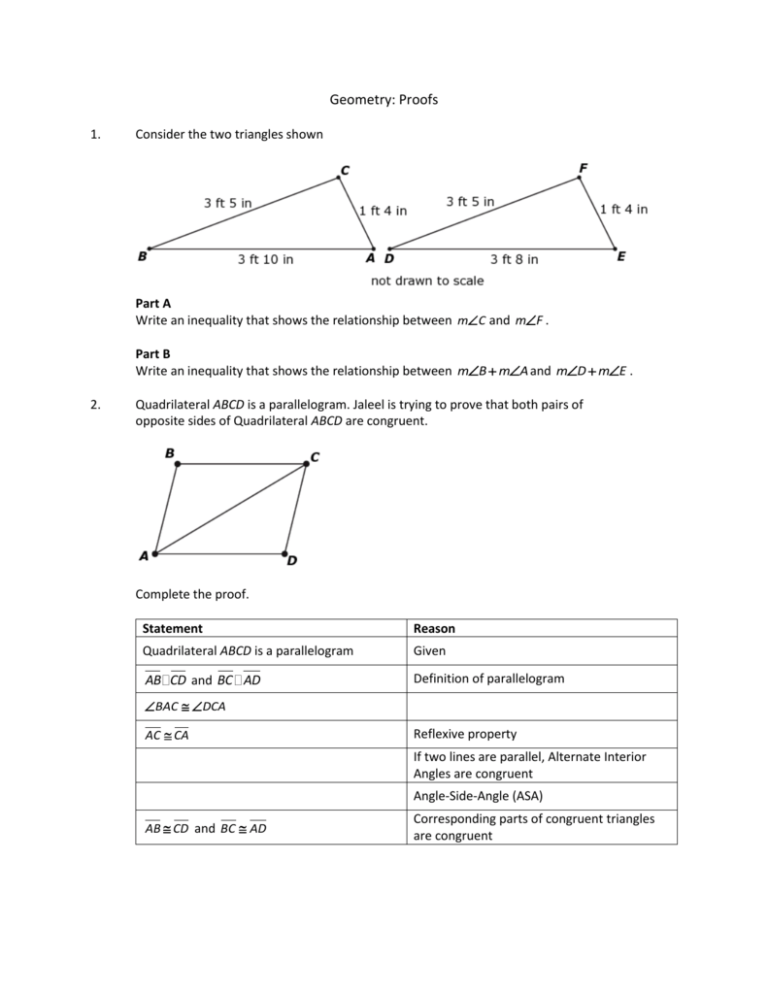Geometry Proofs: Triangle Inequalities & Parallelograms
advertisement

Geometry: Proofs 1. Consider the two triangles shown Part A Write an inequality that shows the relationship between mC and mF . Part B Write an inequality that shows the relationship between mB mA and mD mE . 2. Quadrilateral ABCD is a parallelogram. Jaleel is trying to prove that both pairs of opposite sides of Quadrilateral ABCD are congruent. Complete the proof. Statement Reason Quadrilateral ABCD is a parallelogram Given AB CD and BC AD Definition of parallelogram BAC DCA AC CA Reflexive property If two lines are parallel, Alternate Interior Angles are congruent Angle-Side-Angle (ASA) AB CD and BC AD Corresponding parts of congruent triangles are congruent 3. A student in a Geometry class was given this diagram of quadrilateral CDEF. In the diagram: DE CF DC EF The student wants to prove quadrilateral CDEF is a parallelogram. Six reasons are shown, labeled 1 through 6. 1. Definition of parallelogram 2. Given 3. Side-Side-Side (SSS) 4. Reflexive property of equality 5. Alternate interior angles are equal, so lines are parallel 6. Corresponding parts of congruent triangles are congruent Use the numbers 1 through 6 in the appropriate order to prove quadrilateral CDEF is a parallelogram. Statement DE CF and DC EF DF DF CDF EFD 1 3 and 2 4 CD FE and DE CF CDEF is a parallelogram Reason 4. Given: MT bisects AMH MA MH Prove: AT TH Six statements and reasons are shown, labeled 1 through 6. 1. 2. 3. 4. 5. 6. MAT MHT AMT HMT Side-Angle-Side (SAS) Side-Side-Side (SSS) Symmetric property of equality Reflexive property of equality Use numbers 1 through 6 to complete the proof in the table. Statement Reason MT bisects AMH Given MA MH Given MT MT Definition of angle bisector MTA MTH AT TH Corresponding parts of congruent triangles are congruent 5. A student in a Geometry class made this claim: “If two lines are cut by a transversal, then alternate interior angles are congruent.” Part A Draw a diagram that shows two lines cut by a transversal with alternate interior angles that are congruent or circle “None” if there is not a situation that supports the student’s claim. Part B Draw a diagram that shows two lines cut by a transversal with alternate interior angles that are not congruent or circle “None” if the student’s claim is always true. 6. The line through A and B intersects the line through C and D at point P, as shown in the figure. Prove that angle APC is congruent to angle BPD. Teacher Material G-GPE.B Use coordinates to prove simple geometric theorems algebraically G-CO.C Prove geometric theorems G-SRT.B Prove theorems involving similarity Question Claim 1 1 2 3 Key/Suggested Rubric 2 points: mC > mF , or equivalent AND mB mA < mD mE , or equivalent. 1 point: mC > mF , or equivalent OR mB mA < mD mE , or equivalent. 1 point: Statement Reason Quadrilateral ABCD is a Given parallelogram AB CD and BC AD Definition of parallelogram BAC DCA If two lines are parallel, Alternate Interior Angles are congruent, or equivalent AC CA Reflexive property BCA DAC , or If two lines are parallel, Alternate Interior Angles are congruent equivalent BAC DCA , or equivalent AB CD and BC AD 3 3 Angle-Side-Angle (ASA) Corresponding parts of congruent triangles are congruent 1 point: Statement Reason DE CF and DC EF 2 DF DF 4 CDF EFD 3 1 3 and 2 4 6 CD FE and DE CF 5 CDEF is a parallelogram 1 4 3 1 point: Statement Reason MT bisects AMH Given MA MH Given MT MT 6 2 Definition of angle bisector MTA MTH 3 Corresponding parts of congruent triangles are congruent 2 points: Provides diagram of two parallel lines cut by a transversal AND a diagram of two non-parallel lines cut by a transversal. Example: AT TH 5 3 1 point: Provides diagram of two parallel lines cut by a transversal OR a diagram of two non-parallel lines cut by a transversal. 6 3 2 points: Provides a complete proof in any form (two-column, paragraph, using transformations, etc.) Example 1: Lines AB and CD intersect like they said at point P. This means angle APB is a straight angle of 180° by definition. The same is true of angle CPD. So angle CPA plus angle APD equals 180° because they are nonoverlapping angles that form angle CPD. Same is true for angles APD and DPB since they are non-overlapping angles that form angle APB. Since angle APD is congruent to itself by the reflexive property, and angle CPA plus angle APD equals angle APD plus angle DPB since they both equal 180°, angle APC equals angle DPB by substitution. Example 2: Line CD passes through point P, as given. A rotation of 180° of point D about point P maps D onto ray PC because line CD forms a straight angle. The same is true for point B; a rotation of 180° of point B about point P maps B onto ray PA. Since point D can be anywhere on ray PD, and likewise for point B on ray PB, a rotation of the point has the same effect as a rotation of the entire ray. So a simultaneous rotation of rays PD and PB 180° in the same direction map rays PD and PB onto rays PC and PA respectively. And since rotations maintain angle measures, angle APC is congruent to angle BPD. 1 point: Provides a partial proof that has 1 or 2 errors or omissions.





